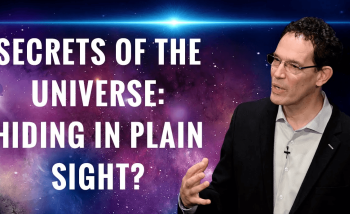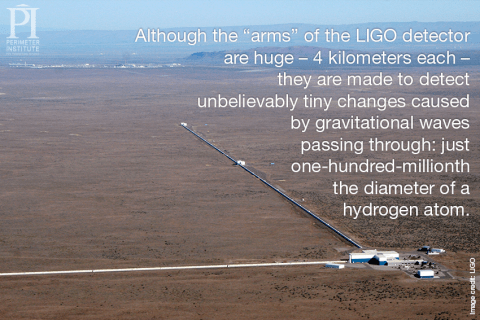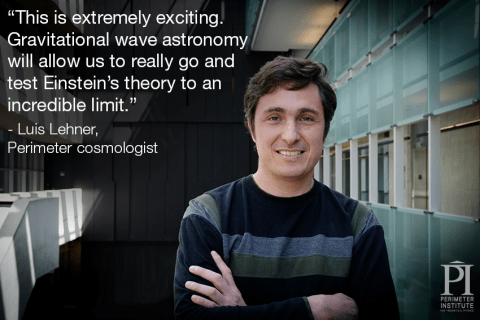Born in the maelstrom of two colliding black holes and flung outward with the energy of all the stars combined, the gravitational wave raced through the universe for 1.3 billion years.
On Earth, continents settled. Swamp forests grew, fell, and slowly turned into coal. Dinosaurs came, dinosaurs went. Mammals ascended.
Then, in the span of just 100 years, humans not only worked out that gravitational waves could exist, but also developed incredibly sensitive instruments with which to detect them.
And during an engineering test, four days before the official launch of the Advanced Laser Interferometer Gravitational-Wave Observatory (aLIGO), the gravitational wave passed through the Earth – as it passes through everything – and continued on its way, impervious to the spacetime it so subtly distorts.
All it left behind on September 14, 2015, was a “chirp” recorded by LIGO’s two detectors, a host of exhilarated scientists, and the question: what next?
For theoretical physicists, this is a thrilling and challenging proposition. “There is a completely new game,” said Perimeter cosmologist Latham Boyle. “From now on, for any astrophysical process, we have to ask: if gravitational waves were produced by such an event, how much more can we learn?”
Gravitational waves are ripples in the fabric of spacetime, created when two massive objects – like black holes or neutron stars – hurtle around each other at extremely high speeds and collide. The energy created is mind-bogglingly immense, but because gravity is such a weak force, the resulting gravitational waves are detectable only by extremely sensitive instruments.
The waves are a logical extension of Einstein’s general theory of relativity. But general relativity is known to be wrong somewhere, because it does not mesh well with quantum mechanics.
Now, theorists like Perimeter Faculty member Luis Lehner are eyeing gravitational waves as a way to test general relativity in extreme circumstances, and potentially find its breaking points. “Eventually, when we get more and more data, we may actually get to see departures [from the theory], and that will guide us in the search for what replaces general relativity,” Lehner says.
LIGO scientists are ready to put the detection of gravitational waves to immediate use. Chad Hanna, a former Perimeter postdoctoral researcher who is now an assistant professor at Penn State and a member of the LIGO collaboration, says real-time notifications of gravitational wave detections could prove game-changing.
“With this knowledge, we can inform other astronomers who can point their telescopes in the direction of the event, in the hope that the gravitational wave will have an electromagnetic counterpart,” Hanna wrote in an article for TheConversation.com.
“Having information from both channels is a bit like having both sound and picture when watching a film.” Lehner adds that such capabilities could take a large dose of serendipity out of astronomy.
The impact of all this, according to Boyle, is set to be felt across many fields, not just the understanding of gravity in astrophysics. “Before the development of radio astronomy, there was the general impression among astronomers that it wasn’t worth doing because there was nothing to see,” Boyle said.
Instead, radio telescopes unleashed “a flood of all sorts of crazy discoveries,” from the cosmic microwave background to pulsars and quasars.
“Most people, including myself, think nowadays we more or less know what’s out there, and that the exciting things that LIGO will see will be ‘merely’ ginormous black holes merging to form other black holes,” Boyle said. “It’s just a historical fact that, often, you see wilder stuff.”
And that “wilder stuff” might just include the dark matter and dark energy that account for 94 percent of the universe. As the name suggests, we cannot see the dark universe, but its existence is inferred through its gravitational effects. Thus, it is a perfect candidate for exploration using gravitational wave astronomy.
Astrophysicist Avery Broderick, an assistant professor at the University of Waterloo and Perimeter Associate Faculty member, is keenly interested in this new channel for exploration, and what it could reveal about both the visible and the dark universe.
“I would be shocked if, when we look with gravitational eyes, we don’t see the universe as totally different,” he said. “Having these sorts of efforts to try to connect the two is going to be absolutely critical to understanding how the dark universe and the light universe fit together.”
LIGO isn’t the only facility with its eye on the gravitational universe. A number of proposals – some in development, others still on the drawing board – aim to target different frequencies in the gravitational wave spectrum.
Earth-bound detectors, such as LIGO, VIRGO, and KAGRA, target high-frequency gravitational waves (those with a period of milliseconds), such as those created by the collision of two black holes.
A space-based interferometer called eLISA, planned by the European Space Agency, targets low-frequency waves with a period of minutes to hours, such as those predicted in the merging of supermassive black holes. (A precursor mission, the LISA Pathfinder, launched in December 2015.)
And a third experiment, called the Pulsar Timing Array, aims to detect very-low-frequency gravitational waves, with a period of years to decades, by using radio telescopes to monitor the highest precision clocks in the universe: millisecond pulsars.
For early-career researchers, LIGO’s detection presents a tantalizing opportunity. Perimeter particle physicist Asimina Arvanitaki has already proposed novel probes for fundamental physics. For her, gravitational waves provide another tool that can be hacked by scientists looking for things other than the waves.
“It’s truly the opening of a new field,” she said. “The future is very bright. We don’t know what we’ll see. Every time we’ve looked at the universe at a different frequency and a different wave, we’ve found something new. Surprises are bound to come.”
Further exploration
- A Capella Science's Tim Blais puts the groove into gravitational waves in this nerd-pop parody, "LIGO, Feel That Space"
- Want to know more? Perimeter’s Slice of PI page has information sheets, videos, and a funky musical interpretation of the LIGO discovery.
- Watch “Ripple Effects: A Forum on Gravitational Waves” on Perimeter’s YouTube channel.
- Attention teachers: Perimeter’s in-class resource about gravitational waves is free in our online store!
About PI
Perimeter Institute is the world’s largest research hub devoted to theoretical physics. The independent Institute was founded in 1999 to foster breakthroughs in the fundamental understanding of our universe, from the smallest particles to the entire cosmos. Research at Perimeter is motivated by the understanding that fundamental science advances human knowledge and catalyzes innovation, and that today’s theoretical physics is tomorrow’s technology. Located in the Region of Waterloo, the not-for-profit Institute is a unique public-private endeavour, including the Governments of Ontario and Canada, that enables cutting-edge research, trains the next generation of scientific pioneers, and shares the power of physics through award-winning educational outreach and public engagement.
You might be interested in


Spiralling light from M87’s supermassive black hole reveals strong magnetic fields
November 8, 2023



